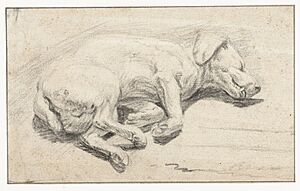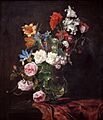Jan Fyt facts for kids
Jan Fyt (born August 19, 1609 – died September 11, 1661) was a famous Flemish artist from the Baroque period. He was a painter, a draughtsman (someone who draws), and an etcher (someone who makes prints). Fyt was one of the most important artists of the 1600s who specialized in still life paintings and animalier art. Still life means paintings of objects like flowers or fruit. Animalier means art focused on animals. Jan Fyt was well-known for his beautiful paintings of flowers, fruit, animals, and exciting hunting scenes. He likely taught Pieter Boel, another famous artist whose style was very similar to Fyt's.
Contents
Life of Jan Fyt
Jan Fyt was born in Antwerp, a city in what is now Belgium. His father was a rich merchant. In 1621, when Fyt was about 12 years old, he became an apprentice at the Antwerp Guild of St Luke. This Guild was like a special club or union for artists. He trained with a painter named Hans van den Berghe.
Fyt probably finished his training with Frans Snyders, a leading animal painter in Antwerp, between 1629 and 1631. In 1630, Fyt officially became a master artist in the Guild of St Luke.
Travels in Europe
In 1633, Jan Fyt began a long trip to Southern Europe. He stopped in Paris, France, for a while. The next year, he traveled to Italy. He worked in Venice for important families like the Sagredo and Contarini.
In 1635, he lived in Rome. While there, he joined a group called the Bentvueghels. This was a club for Dutch and Flemish artists working in Rome. Members of the Bentvueghels often chose fun nicknames. Fyt's nickname was reportedly 'Goudvink', which means 'bullfinch'. During his time in Italy, he likely visited other cities like Naples, Florence, and Genoa. Some art historians also believe he traveled to Spain and London.
Return to Antwerp
By 1641, Fyt was back in Antwerp. He stayed there for the rest of his life, except for a short trip to the Dutch Republic (modern-day Netherlands) that same year. Fyt had a very successful art studio in Antwerp. His studio made many copies of his paintings.
He became a wealthy man and had many connections with art buyers and dealers. These connections were both in Antwerp and in other countries.
In 1650, Fyt joined the Guild of Romanists. This was another important society in Antwerp for famous people and artists. To join, you had to have visited Rome. In 1652, the Guild chose Fyt to be its leader, called the dean.
Jan Fyt married Françoise van de Sande on March 22, 1654. They had four children together. He passed away in Antwerp on September 11, 1661.
Some of Fyt's students included Pieter Boel and Jaques van de Kerckhove. Pieter Boel's art style stayed very similar to Fyt's.
Jan Fyt's Artworks
Fyt was a very skilled artist who specialized in still life paintings. While he is most famous for his hunting scenes, game (animals hunted for food), and animal paintings, he also created beautiful still life pictures of flowers and fruit. He painted a lot, creating about 280 paintings. Many of these paintings are signed and dated by him.
Important art collectors of his time wanted his works. Today, his paintings can be found in many top museums around the world.
Fyt's animal still life paintings are often more detailed and elegant than those by Frans Snyders. This is because Fyt mostly painted for rich and noble clients. His use of colors was likely influenced by the Italian art he saw during his travels. His colors were often more striking than Snyders'. Fyt's paintings also show more movement and less perfect balance over time. His quick, energetic brushstrokes and more dramatic style were different from Snyders'. Fyt was especially good at showing the different textures of animal fur and bird feathers.
Hunting Scenes
Jan Fyt changed how hunting scenes were painted. Before him, dead animals from a hunt were usually shown on a table inside a house. Fyt moved these scenes outdoors, into an open landscape.
He was the first artist to show game animals as trophies from a hunt, not just as food in a kitchen. He didn't put fruit and vegetables in his game paintings. Instead, he included dogs that were part of the hunt, set in an outdoor scene. Because the animals were shown as trophies, these works are sometimes called "trophy pieces."
This new way of showing game meant Fyt also included hunting tools and equipment in his paintings. Hunting dogs were very important in these scenes. The dogs and hunting gear showed that the hunter was nearby. Sometimes, Fyt even included portraits of people and families in these hunting scenes.
At that time, hunting was mostly a hobby for rich, noble families. However, wealthy city people also wanted Fyt's hunting paintings. They used them to decorate their homes, showing off a lifestyle that only the rich could afford.
Some of Fyt's hunting paintings show the scene as if an animal is watching it. An example is the Dead Game and Weasels (around 1642). This idea of showing things from an animal's point of view might have been Fyt's way of thinking about new ideas from the 1600s. These ideas explored how animal and human minds might be similar or different.
Fyt's new style of hunting paintings influenced other artists in France and the Netherlands.
Collaborations with Other Artists
It was common in Antwerp for artists to work together. Fyt often teamed up with other painters who specialized in different areas. For example, he worked with artists who were experts in painting people, landscapes, or buildings.
He collaborated with painters like Cornelius Schut and Thomas Willeboirts Bosschaert for figures. He might have also worked with Jacob Jordaens sometimes. For figures and buildings, he worked with artists like Erasmus Quellinus II.
Drawings
Jan Fyt made many drawings of animals. He usually drew them by studying real animals. The Hermitage Museum has a large drawing by Fyt called Fox Hunt. It uses rich colors and is very carefully made. It was probably meant to be a design for a tapestry (a woven picture).
Engravings
Fyt was also a skilled etcher. He created a series of etchings, mostly showing animals and dogs. These were published during his lifetime in two sets. They were called the Set of the Dogs and the Set of the Animals.
The Set of the Dogs had 8 prints and was published in 1642. The first print shows two hunting dogs in front of a stone stand. It is dedicated to Don Carlo Guasco, a Spanish nobleman who supported the publication. The other prints show dogs doing different things.
The Set of the Animals also had 8 prints. These showed animals like billy goats, an ox, a horse, a resting dog, a resting cow, a wagon near a tree, another resting cow, and two foxes.
Images for kids
See also
 In Spanish: Jan Fyt para niños
In Spanish: Jan Fyt para niños









